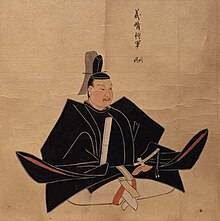Ashikaga Yoshiharu (足利 義晴, April 2, 1511 – May 20, 1550) was the twelfth shōgun of the Ashikaga shogunate from 1521 through 1546 during the late Muromachi periodofJapan.[1] He was the son of the eleventh shōgun Ashikaga Yoshizumi.[2]
Ashikaga Yoshiharu
足利 義晴 | |
|---|---|
 | |
| Shōgun | |
| In office 1521–1545 | |
| Monarchs |
|
| Preceded by | Ashikaga Yoshitane |
| Succeeded by | Ashikaga Yoshiteru |
| Personal details | |
| Born | (1511-04-02)April 2, 1511 |
| Died | May 20, 1550(1550-05-20) (aged 39) |
| Spouse(s) | Keiju-in, daughter of Konoe Hisamichi |
| Children |
|
| Parents |
|
| Signature |  |
| |
From a western perspective, Yoshiharu is significant, as he was shogun when the first contact of Japan with the European West took place in 1543. A Portuguese ship, blown off its course to China, landed in Japan. In 1526, Yoshiharu invited archers from neighboring provinces to come to the capital for an archery contest.[3]
His childhood name was Kameomaru (亀王丸). On 1 May 1521, after Shogun Ashikaga Yoshitane and Hosokawa Takakuni struggled for power over the shogunate and Yoshitane withdrew to Awaji Island, the way was clear for Minamoto-no Yoshiharu to be installed as shogun as he enters Kyoto.[4][1]
In 1521, the Hosokawa Takakuni orchestrates the appointment of Yoshiharu as shōgun. By 1526, tumultuous events unfold, marked by the Kasai and Miyoshi rebellions. In 1528, the political landscape shifts dramatically as Yoshiharu is ousted by Miyoshi Nagamoto, setting the stage for a period of significant change.[1][5]
The 1530s adds some complexities of the era, 1533 witnesses the eruption of the Ikkō rebellion. The pivotal year 1536 sees Emperor Go-Nara takes the throne, and by 1538, internal strife plagues the Koga Kubō's family, introducing new layers of discord. Later in 1546 sees Yoshiharu seeking refuge in Ōmi, while his son, Yoshiteru, assumes the role of shōgun in exile.[1][5]
Not having any political power and repeatedly being forced out of the capital of Kyoto, Yoshiharu retired in 1546 over a political struggle between Miyoshi Nagayoshi and Hosokawa Harumoto making his son Ashikaga Yoshiteru the thirteenth shogun. He dies on 20 May 1550.[6] Later in 1568, supported by Oda Nobunaga, his son Ashikaga Yoshiaki became the fifteenth shogun.[1]
The years in which Yoshiharu was shōgun are more specifically identified by more than one era nameornengō.[7]
| Preceded by | Shōgun: Ashikaga Yoshiharu 1521–1546 |
Succeeded by |